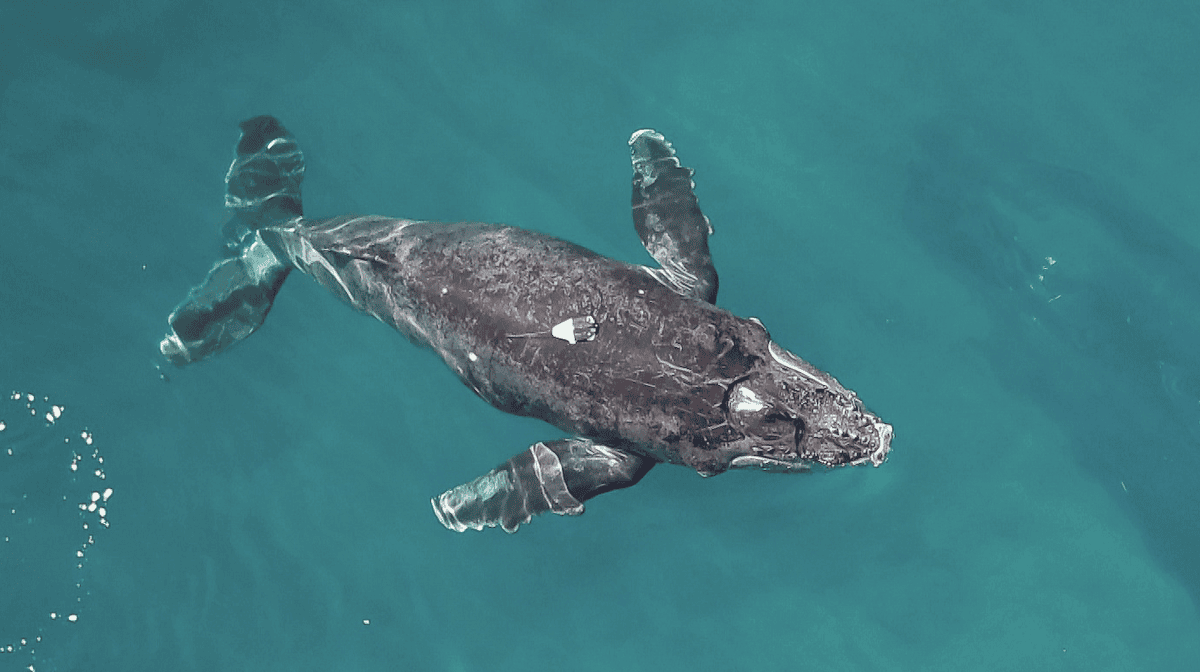- New video reveals baby humpback whales nursing in Hawaii, a sight rarely seen by humans.
- A team of researchers used non-invasive suction cups to outfit seven baby humpback whales with special tags for recording data on nursing as well as other whale behaviors.
- During their time in Hawaii, the whale calves must drink enough milk to fatten up for a one to two-month migration back to Alaska.
- The researchers hope to understand the needs of mother whales and their calves during their time in the tropical breeding grounds and for their long migration.
Newly released video footage gives us a glimpse of a rarely seen behavior: baby humpback whales nursing in the sheltered breeding grounds of Maui. Here, the young calves must drink enough milk to fatten up for an epic journey: an up to two-month migration across the Pacific Ocean to Alaska.

A team of researchers used non-invasive suction cups to outfit seven baby humpback whales (Megaptera novaeangliae) with CATS tags. Each specialized tag contains a built-in camera, acoustic recorder, depth sensors and tri-accelerometers, and was designed to provide information on the whales’ social interactions, movements, breathing patterns, nursing behavior and nursing frequency. The scientists hope to use this information to better understand the needs of mother whales and their calves during their time in the tropics.
Lars Bejder, director of the Marine Mammal Research Program at the University of Hawaii at Mānoa, and Ph.D. candidates Martin van Aswegen and Will Gough tagged and recorded the whales over a 10-day period in February 2020. The project is a collaboration between the Marine Mammal Research Program, the Goldbogen Lab at Stanford University’s Hopkins Marine Station, the Friedlaender Lab at the University of California, Santa Cruz, the Hawaiian Islands Humpback Whale Sanctuary, Pacific Whale Foundation and the Oceanwide Science Institute.
“What we are trying to understand with these new technologies is how much time do calves need to nurse from their moms to get strong and big enough to be able to make their journey back up north to their Alaskan feeding grounds,” Bejder said in a statement.
In the winter, around 10,000 humpbacks migrate roughly 5,000 kilometers (3,000 miles) from Alaska to Hawaii to breed. Once a female leaves her foraging ground in Alaska and comes to Hawaii, she doesn’t feed again until she’s back up in Alaska, four or five months later.
“She [the mother whale] has to stop feeding, migrate all the way to Hawaii, give birth to a calf, lactate and fatten-up the calf so it is big and strong enough to be able to migrate with her back up to Alaska to start feeding,” Bejder told Mongabay. “Getting an understanding of how much time these animals need to suckle is really important.”

When its time to remove the tags, a current burns a small wire inside the device and the tag pops off, floats to the surface and sends out a signal via a VHF antenna. Scientists use a directional antenna to track and retrieve the device.
“That’s the most nerve-wracking part, getting these tags back,” Bejder said. “Getting them on, of course, requires a bit of experience, but knowing when they’re off and then finding them is when you don’t sleep…you don’t want to lose these tags.”
In addition to the CATS tags, the team also used drones to calculate body condition and body length, which can be used to determine age. Using custom-fitted altimeters, a tool for measuring height, and a special camera lens, the researchers were able to evaluate the thickness and the width of the animal all the way down the body. By taking these measurements of the same animal over time, the team can calculate how its volume changes over the season.
“While they’re feeding up there in Alaska for four or five months, how big do they get?” Bejder asks. “And then, once they get down here [Hawaii], how much weight have they lost? And also, just when they returned back up to Alaska, how much weight have they lost through that whole cycle?”
It turns out, a lactating female can lose up to 40% of her body mass during this cycle, according to work by Ph.D. candidate van Aswegen. This massive change can happen every two to three years for breeding females.
“Mother whales have to stack on lots and lots of blubber to be able to fuel that migration,” Bejder said.

Adult humpbacks are roughly the size of a school bus and weigh around 30,000 kilograms (66,000 pounds). They sing complex underwater songs to communicate, and in addition to filtering food with their baleen, they have been known to cast nets of bubbles to capture fish.
These iconic marine mammals were once hunted to the brink of extinction by commercial whaling, but rebounded after a 1966 moratorium on hunting and inclusion in the U.S. Endangered Species Conservation Act (predecessor to the current ESA) in 1970. Now, an estimated 80,000 humpbacks live in oceans in the northern hemisphere. Nevertheless, humpbacks still face threats from entanglement in nets, noise pollution, and climate change.
Climate change is occurring very clearly in both the northern and southern polar regions, says Bejder, and that’s where the majority of prey items are. As the climate warms and the oceans change, this may alter prey distribution. Shifts in prey toward the poles mean a longer migration for whales.
“The [humpback] migration is a fine-tuned machine,” Bejder said, “it has to be really well timed.”

Banner image of a humpback whale calf courtesy of the Marine Mammal Research Program at the University of Hawaii.
Liz Kimbrough is a staff writer for Mongabay. Find her on Twitter @lizkimbrough
FEEDBACK: Use this form to send a message to the author of this post. If you want to post a public comment, you can do that at the bottom of the page.
